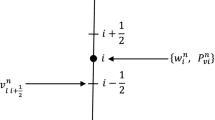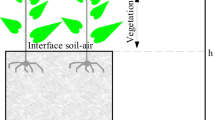Abstract
An explicit finite differences routine was developed to simulate three-dimensional water flow from trickle irrigation under unsaturated conditions; the code was validated by comparison with analytical solutions, other existing numerical models and laboratory experiments. Recently, the model was improved to reproduce flow root absorption via a time-dependent macroscopic approach using the same function as a capacitor charging system in a DC circuit. This paper presents the root-absorption model characteristics and some simulation results, which are some of them compared to experimental data obtained from a tomato plant crop cultivated in a greenhouse at the site of Natabuela (Ecuador). From the simulations performed it is concluded that evolution of the wetting front advances as the water content patterns are acceptable from a physical point of view, and they agree with experimental observed data for some of the irrigation conditions that were tested. On the other hand, the model has been used to evaluate the irrigation practices of tomato farmers at Imbabura province (Ecuador); in this way, some advices about suitable irrigation doses, frequency and emitter`s spacing selection, are provided at the end of this work.











Similar content being viewed by others
Notes
Where \(r\) [cm] represents the distance from the emitter, and \(z\) [cm] is the depth.
As might be notice since: \({\theta }_{a}\left(\tau \right)=\varepsilon \left(1-{e}^{-1}\right)=0.63\varepsilon\).
This value is calculated assuming a systematic bound error of ∆r_s=±0.1cm (minimum ruler unit) and a random distribution of probability based on a t-student function for n=4 data which are taken under the same experimental conditions at each time control. Depending on random error: ∆r_f=(0.903,2.723)cm. Figure 1 represents the error bars for the minimum value of ∆r_f=0.903cm.
For instance, evaporation could be lower at \({\theta }_{0}\)-R if the tomato plant shallows part of the soil that is beside it.
References
Coelho FE, Or D (1996) A parametric model for two-dimensional water uptake intensity by corn roots under drip irrigation. Soil Sci Soc Am J 60:1039–1049
Colimba Limaico, J. E., Zubelzu Minguez, S. and Rodriguez Sinobas, L. 2021 Assessing water doses, water use efficiency and tomato quality under greenhouse conditions in Natabuela-Ecuador. European Geoscience Union 2020, session SSS9.4/EGU21–2911 - The challenges of irrigation in the COVID19 scenario. Viena, Austria
del Vigo Á., Zubelzu S. & Juana L (2019a). Algoritmo para la resolución de la ecuación de Richards en 3-D para riego por goteo: Método, validación y resultados preliminares. XXXVII Congreso Nacional de Riegos. Don Benito. Spain. http://hdl.handle.net/10662/9217
del Vigo Á., Zubelzu S. & Juana L (2019b). Study of water infiltration in soil by Richards equations in 3D: summary and methodology validation. 11th World Congress on Water Resources and Environment. Madrid. http://ewra.net/pages/EWRA2019b_Proceedings.pdf
del Vigo Á, Zubelzu S, Juana L (2020) Numerical routine for soil water dynamics from trickle irrigation. Appl Math Model 83:371–385. https://doi.org/10.1016/j.apm.2020.01.058
del Vigo, Á (2020b). Simulación del flujo del agua en el suelo en riego por goteo superficial, soluciones analíticas aproximadas, caracterización del suelo y diseño de los riegos. Phd. Thesis, Universidad Politécnica de Madrid. Madrid. https://doi.org/10.20868/UPM.thesis.63840
del Vigo Á, Somolinos B (2021) Teoría de Circuitos. Problemas resueltos. García Maroto, Madrid
del Vigo Á, Juana L, Rodríguez-Sinobas L (2022) Modelo numérico de simulación del flujo de agua en el suelo afectado por la absorción de la raíz. Ingeniería Del Agua 26(1):37–46. https://doi.org/10.4995/ia.2022.16531
Feddes RA, Kowalik P, Kolinska-Malinka K, Zaradny H (1976) Simulation of field water uptake by plants using a soil water dependent root extraction function. J Hydrol 31:13–26
Feddes RA, Kowalik P, Zaradny H (1978) Simulation of field water use and crop yield. Simulation monographs. Centre for Agricultural Publishing and Documentation, Wageningen
Friedman SP, Communar G, Gamliel A (2016) DIDAS-User-friendly software package for assisting drip irrigation design and scheduling. Comput Elect Agric 120:36–52
Gardner WR (1960) Dynamic aspects of water availability to plants. Soil Sci 89:63–73
Gardner WR (1964) Relation of root distribution to water uptake and availability. Agron J 56:41–45
Gardner WR (1965) Dynamic aspects of soil-water availability to plants. Ann Rev Plant Physiol 16:323–342
Hopmans JW, Bristow KL (2002) Current capabilities and future needs of root water and nutrient uptake modeling. Adv Agron 77:104–175
Lubana PPS, Narda NK, Brown LC (2002) Application of a hemispherical model to predict radius of wetted soil volume under point source emitters for trickle irrigated tomatoes in Punjab state. Trans ASABE 32:243–257
Molz FJ, Remson I (1970) Extraction term models of soil moisture use by transpiring plants. Water Resour Res 6:1346–1356
Musters PAD, Bouten W (1999) Assessing rooting depths of an Austrian pine stand by inverse modelling soil water content maps. Water Resour Res 35:3041–3048
Neuman SP, Feddes RE, Bresler E (1975) Finite element analysis of two-dimensional flow in soils considering water uptake by roots. Soil Sci Soc Am Proc 39:225–230
Ozgur K, Payam K, Salim H, Bakhtiar K, Nazir K (2021) Modeling wetting front redistribution of drip irrigation systems using a new machine learning method: adaptive neuro- fuzzy system improved by hybrid particle swarm optimization – Gravity search algorithm. Agric Water Manag 256:107067
Philip JR (1991) Effects of root and sub irrigation on evaporation and percolation losses. Soil Sci Soc Am J 55:1520–1523
Rodriguez-Sinobas, L., Colimba-Limaico, J. E., and Zubelzu, S (2020). Development of criteria to improve water use efficiency in tomato crop (Solanum lycopersicum L.) under greenhouse in Ecuador, EGU General Assembly 2020. 4–8 May 2020. Ecuador
Schaap MG, Leij FJ, van Genuchten MT (2001) ROSETTA: a computer program for estimating soil hydraulic parameters with hierarchical pedotransfer functions. J Hydrol 251:163–176
Šimůnek J., van Genuchten M. & Šejna M (2006). The HYDRUS Software Package for Simulating the Two- and Three-Dimensional Movement of Water, Heat, and Multiple Solutes in Variably-Saturated Media, Technical Manual Version 1.0. University of California Riverside. Riverside, CA, 3PC. Progress, Prague. Czech Republic
Vrugt JA, van Wijk MT, Hopmans JW, Simunek J (2001) One, two and three dimensional root water uptake functions for transient modelling. Water Resour Res 37(10):2457–2470
Warrick AW, Lomen DO, Amoozegard-Fard A (1980) Linearized moisture flow with root extraction for three-dimensional, steady conditions. Soil Sci Soc Am J 44:911–914
Zapata-Sierra AJ, Moreno-Pérez MF, Reyes-Requena R, Manzano-Agugliaro F (2021) Root distribution with the use of drip irrigation on layered soils at greenhouses crops. Sci Total Environ 768:144944
Acknowledgment
Javier Ezcequiel Colimba Limaico wants to thank Secretaría de Educación Superior, Ciencia, Tecnología e Innovación (SENESCYT) and Instituto de Fomento al Talento Humano, of the Government of the Republic of Ecuador for supporting its PhD studies.
Author information
Authors and Affiliations
Corresponding author
Ethics declarations
Conflict of interest
The authors declare no conflict of interest.
Additional information
Publisher's Note
Springer Nature remains neutral with regard to jurisdictional claims in published maps and institutional affiliations.
Rights and permissions
About this article
Cite this article
del Vigo, Á., Colimba, J., Juana, L. et al. Numerical model for the simulation of soil water flow under root-absorption conditions. Application to tomato plant crop. Irrig Sci 41, 141–154 (2023). https://doi.org/10.1007/s00271-022-00806-x
Received:
Accepted:
Published:
Issue Date:
DOI: https://doi.org/10.1007/s00271-022-00806-x




